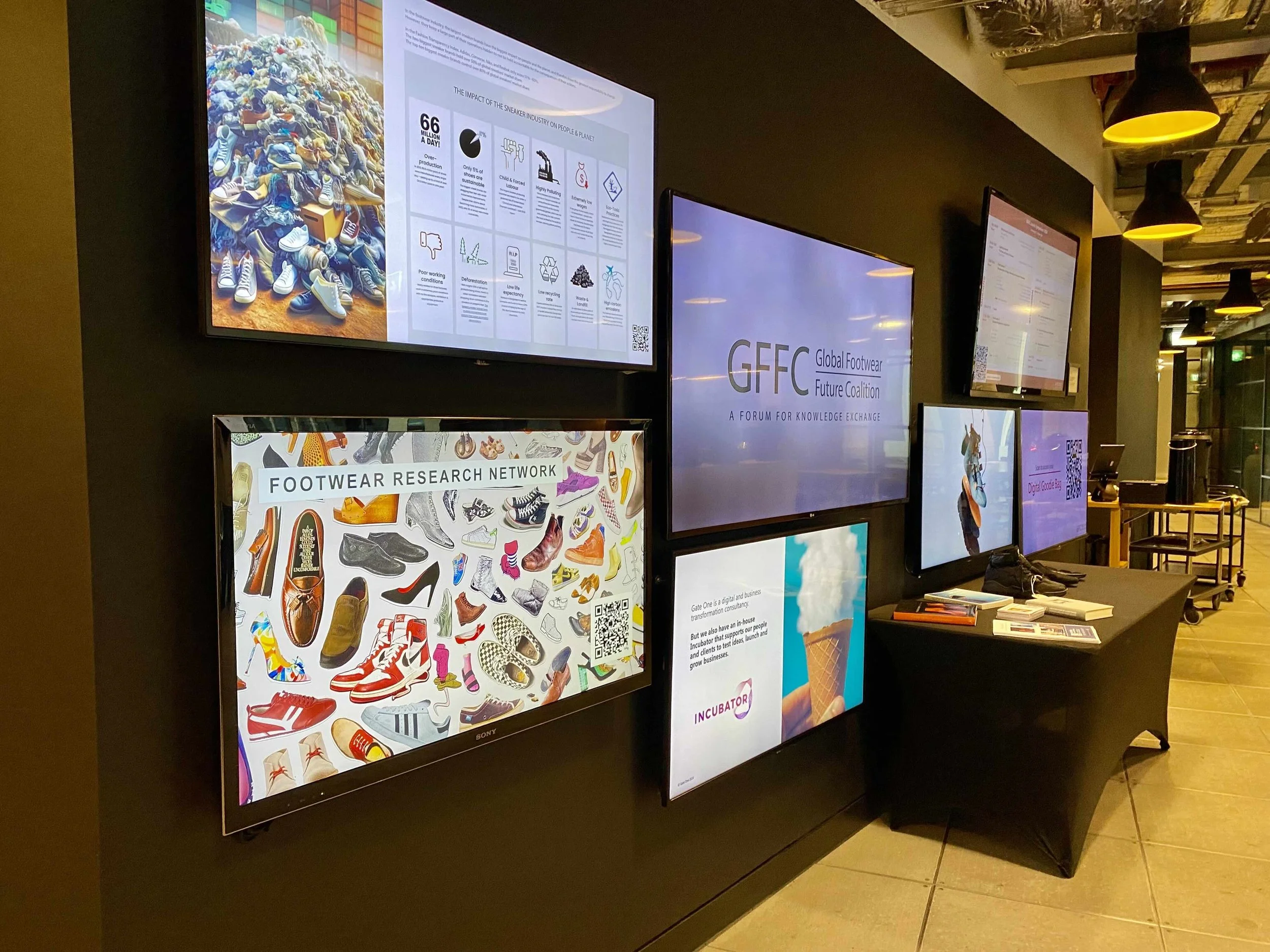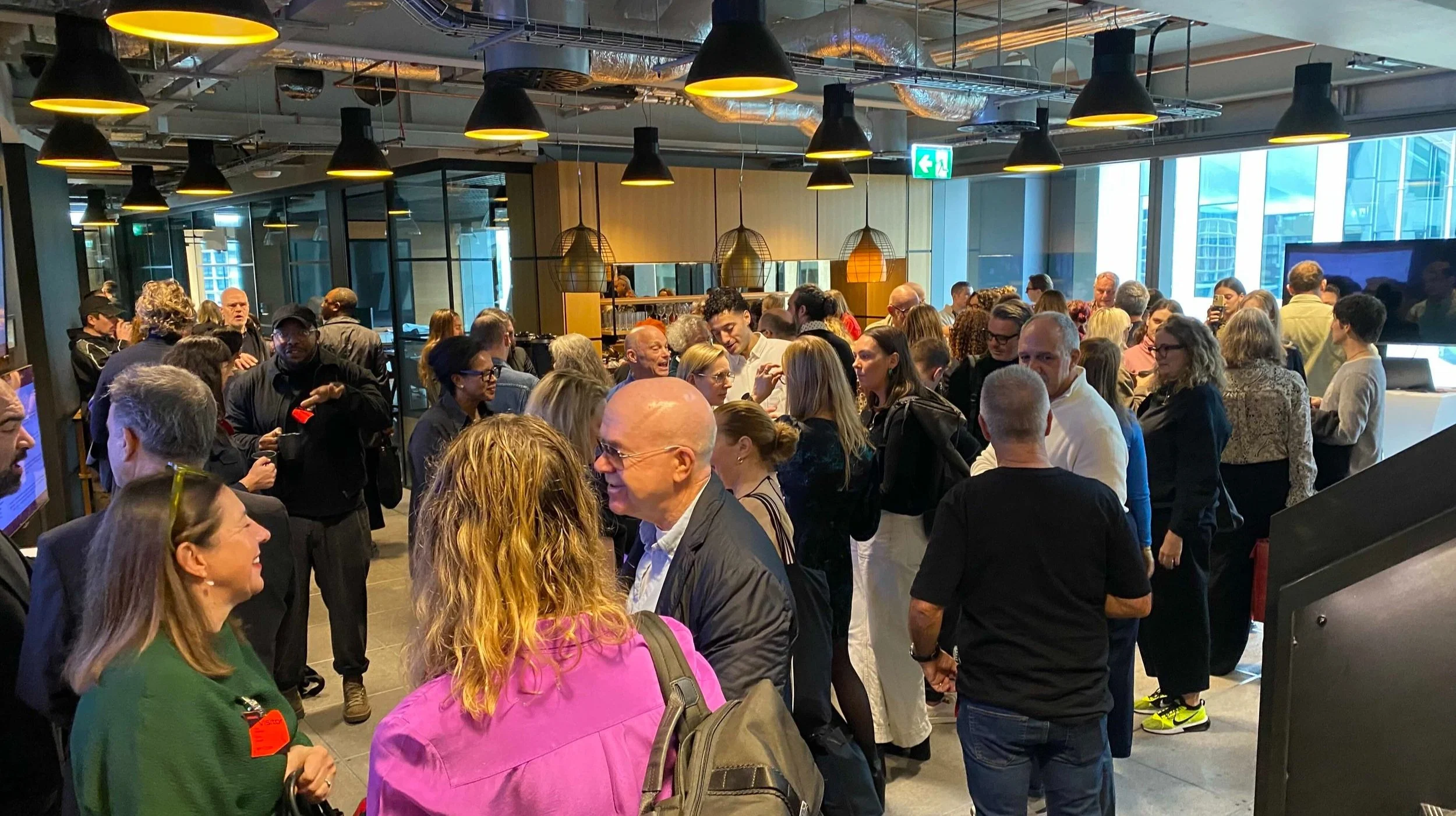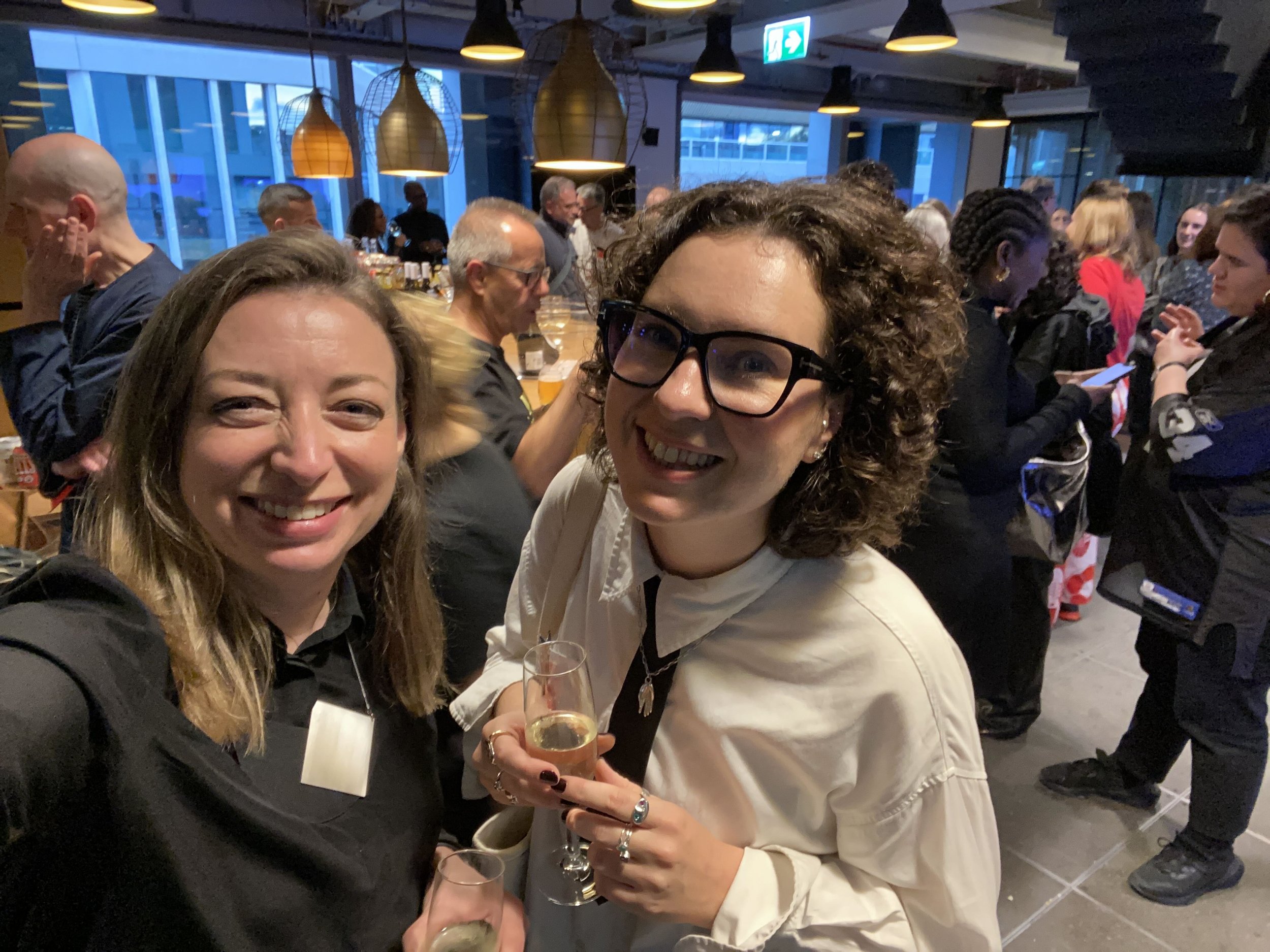Reflections on the Global Footwear Future Coalition Launch – London, 9th October 2024
Last Wednesday marked the eagerly anticipated inaugural event of the Global Footwear Future Coalition, which took place at the spectacular Havas Village in London’s Kings Cross.
The coalition was founded in January 2024 by academic, author, and designer Darla Gilroy to provide a global forum for footwear knowledge exchange and collaboration among brands, retailers, makers, trade bodies, cultural institutions, research, academia, and government. As an academic-led initiative, the coalition exists in a pre-competitive space to reset the footwear industry and address systemic challenges.
The day-long event featured powerful keynote presentations, panel discussions, intimate working sessions and networking opportunities.
As a member of the founding team, the event exceeded all my expectations. Along with the rest of the team, including fellow academic and designer Liz Ciokajlo, Joe Kearins, Principal at strategy and transformation consultancy Gate One, Havas, and Sarah Byfield-Riches, a specialist in creative commercial partnerships, I was overwhelmed by the energy and expertise in the room and the will amongst delegates to make change. More than anything, I sensed an overwhelming desire to stop focusing on problems and start working on solutions… together.
Setting the Stage: Opening Address and Keynote
Appropriately set against the backdrop of UAL’s Central Saint Martins, the day commenced with a welcome by Gate One Managing Partner Ben Tye and an inspiring address by coalition founder Darla Gilroy. The opening keynote by Daniel Rubin, Founder and Executive Chairman of the Dune Group, provided an important reflection on the footwear industry's past as we consider its future.
Rubin explained that the footwear manufacturing process has remained materially unchanged for the past 50 years. It was encouraging to hear such an influential footwear veteran identify what he described as an “urgent need to rethink the environmental, social and economic impact of our industry and educate consumers on the importance of embracing sustainable footwear”.
A key problem for Rubin was the constant quest for cheap shoes and labour, adding that changing the system would require collective action and collaboration, highlighting the need for initiatives such as the GFFC “to bring a fragmented industry together.”
Panel 1: Innovations in Design, Manufacturing, and Education
Addressing Circularity and Waste
The first panel was chaired by Yasmin Jones-Henry, writer for the Financial Times and Curator of The Lab E20. A key highlight for me was a conversation about how each panellist defined and tackled the concept of circularity, which emerged as a vague and ambiguous term, yet full of opportunity.
A main concern amongst panellists was pre- and post-consumer waste. For Asher Clark, Founder and Chief Design Officer at Vivobarefoot, one answer to addressing waste is “making what you need when you need it”. He explained that while there will always be a place for craft and ‘slow’ shoemaking, technology is the answer to making footwear at scale that will one day be net positive. Along with fellow panellist Jamie Hall, Founder and Chief Customer and Services Officer at Pentatonic, Clark also highlighted the need for reverse logistics.
The Role of Technology and Robotics
Potential solutions to these problems came from Susan Postlethwaite, Director of the Robotics Living Lab at the Manchester Fashion Institute. Funded by the AHRC, the lab will explore more sustainable approaches to fashion manufacturing by providing a facility for fashion researchers, designers and manufacturers to work together with robots to create high-value, low-volume fashion.
In agreement with Clark, Postlethwaite highlighted the support that robotics and AI can provide the footwear industry for rethinking design and reshoring production. Relatedly, she underscored the need for a clearer understanding of so-called ‘circular’ innovations to inform genuine claims, something her eagerly awaited current research also addresses.
Consumer Education and Transparency
Jack Millington, Founder of Billy Tannery, provided a complementary view on sustainability and circularity with regenerative leather. As one of the footwear industry’s most contentious materials, Millington drew attention to a need for reform within the leather industry. Addressing consumer expectations is part of this work, highlighting a demand for unblemished leather, which contradicts sustainability goals. In my own research, I explore the emotional durability of leather, something he believes can be enhanced by acknowledging the stories of the leather.
All believed transparency was key in consumer education. Hall proposed that “no consumer wants to be educated by a brand; they want to be informed,” calling for brands to “be transparent and honest.” Acknowledging that very few consumers are likely to read a lifecycle assessment, the need for accessible information delivered in lay terms was also emphasised.
Marketing was identified as a key area for improvement due to a history of greenwashing and lack of consumer trust. When I raised the risks of transparency, cancel culture and the consequent practice of green hushing during the panel discussion, all agreed that it was important for brands to be honest about their ‘dirty laundry’. A journalist for the Financial Times, Yasmin Henry-Jones expressed her compassion towards brands if her research finds that their approach is genuine. There is no silver bullet, and she suggested consumers are more likely to come along on the journey and reserve criticism if brands are up-front from the beginning.
Panel 2: Equitable Responses to Cultural Shifts
Workers' Conditions and Environmental Impacts
Chaired by Elisa Anniss, journalist and lecturer at London College of Fashion, UAL, panel two started passionately. We knew Tansy Hoskins, author of ‘Footwork: What your shoes tell you about globalisation’ would provide a provocative and important perspective, and she didn’t disappoint. Part of the coalition's value is providing a safe space to speak, listen, and work together towards the kinds of reform needed. Many in the room would have witnessed Tansy’s accounts of workers’ conditions and the environmental impacts of footwear manufacturing first-hand (full speech here). The huge applause she received demonstrated a willingness to acknowledge these truths and the consequences of inaction - an essential step towards meaningful and genuine change.
Challenging the Status Quo
The panel continued with discussions with Jen Keane, Co-Founder and CEO of Modern Synthesis and Mark Whelan, UK Chairman and Group Chief Creative Officer for Havas, about the value of challenging the status quo. Keane’s experience developing microbial biotechnology to produce ‘materials that are circular by nature and customisable by design’ highlighted the value of start-ups and small businesses in progressing towards a circular and regenerative industry.
The discussion resonated with many in the audience; during the panel discussion, another small business owner called for better support and collaboration between small, medium and large organisations to address systemic challenges, innovate and future-proof the industry. The coalition was identified as a place where these connections can be made, and post-event feedback suggests delegates certainly made the most of the opportunity to connect.
The Importance of Storytelling
One theme that emerged strongly in panel two and reappeared throughout the day was an essential need for clear and compelling storytelling. As a sociocultural anthropologist this topic resonated deeply with me. Retail veteran Bob Neville, formerly of adidas, New Balance, Under Armour and Clarks, explained, “If you don’t have a story, you only have price, and that’s a downward spiral”. Addressing the supposed demise of retail and the desire for ever-increasing amounts of “cheap stuff”, he explained that, in fact, all that was dead was bad retail; “human beings need human interaction”.
Neville also proposed a need for efficiency. In essence, this means “doing more with less”. Nearly a week on, the concept of doing more with less has stayed at the forefront of my mind. While efficiency can often be associated with exploitation, Neville delivered it as an opportunity for sustainable innovation and increased margins in the context of resources and overproduction. Certainly, necessity is the mother of invention. My research as a design educator has demonstrated that reducing, recycling, and reusing resources leads to improved creativity and increased innovation.
In circumstances where boards and shareholders decide, Neville’s perspective understands the realities of transformation in a capitalist neoliberal economy. He presents and writes widely on the challenges the contemporary marketplace faces, and I highly recommend following him on LinkedIn if you’re interested.
Lunchtime Provocations: Diverse Perspectives on Footwear's Future
Before lunch, delegates were treated to a series of three-minute ‘provocations’ delivered by a range of speakers, including Nicola Pichel-Juan, a sustainability expert at SATRA; Catherine Willems, founder of the Future Footwear Foundation; Sarah Day, education and footwear consultant; designer and lecturer Joyce Addai-Davis; David Allen, Founder of Zen Running Club and Andrew Thompson of Fable Footworks. The speeches provided an exciting opportunity to imagine the kinds of changes that could be possible within the footwear sector.
Afternoon Working Sessions
After a delicious lunch courtesy of Gate One Havas and further networking, the afternoon comprised an opportunity for delegates to participate in two of four ninety-minute working sessions led by the coalition founders in collaboration with industry partners. The sessions addressed challenges and opportunities in the following fields:
Education - Facilitated by Darla Gilroy and Joanne Jørgensen, design and innovation leader formerly of Nike,
Design – facilitated by Liz Ciokajlo and Will Verona, Design Director at Purified,
Business – facilitated by Joe Kearins and Ali Burton, Incubator Manager at Gate One, Havas.
Culture – facilitated by myself and planned with the assistance of Tim Crumplin, business archivist at the Alfred Gillett Trust (Clarks Archive) and Shoemakers Museum and Rosie McKissock, formerly of Clarks.
Focus on the Cultural Sustainability Workshop
Due to the parallel sessions, unfortunately, the GFFC founders and collaborators were unable to attend one another’s working groups, but for the benefit of readers, I can elaborate briefly on my own session, entitled "Understanding and responding to the 'social lives of shoes': A workshop on cultural sustainability,"
The workshop framed culture as the underpinning foundation beneath all other sustainability efforts. If products don't resonate with the values, ideas, beliefs, worldviews, symbols, practices, customs, and artefacts that constitute the cultures that provide us all with a sense of belonging and connection, they're just more stuff people don't need and will end up in landfills, on the discount shelf, or worse, destroyed.
To understand cultural sustainability in the context of footwear design, production, marketing, and retail, I introduced participants to the notion that shoes have social lives. Shoes often find themselves on all sorts of feet in situations and contexts often outside anyone’s control. How shoes are lived and used is how they acquire meaning and significance beyond their initial design and intended purpose—it is how they gain their vitality and accounts partly for how brands acquire identity.
The concept of social lives is inspired by Arjun Appadurai’s edited book ‘The Social Lives of Things: Commodities in Cultural Perspective’ (1986) and Igor Kopytoff’s chapter in the same volume about object biographies. Using my research with the Clarks Originals team and a group of wearers in 2012, reframed for publication with Bloomsbury Academic in 2025/26, the session introduced participants to the importance of understanding the social lives of their shoes and developing cultural and subcultural capital.
A key focus was authenticity in brand culture and its relationship to cultural sustainability. The workshop proposed that culturally sustainable brands learn from, collaborate with and enrich the cultures from which they draw inspiration and their products exist, particularly by acknowledging and respecting the diverse experiences of wearers and producers. To illustrate these ideas in action, a case study of Clarks Originals was presented, specifically the Clarks Originals Remixed campaign in 2012—an example of cultural exchange between Clarks and their Jamaican consumers—and their more recent documentary about Clarks in Tokyo.
Through various activities, including sharing personal shoe stories, evaluating brands on a cultural sustainability scale and exploring barriers and opportunities for understanding the social lives of shoes, participants engaged with these concepts through lively group conversations reflecting personal and professional experiences.
What emerged from these conversations was a sense that actions and decisions deemed anti-cultural, culturally sustainable or culturally regenerative are highly subjective, depending on one’s worldview, which can vary between groups and cultures, particularly in the context of capitalist, neo-liberal economies still reconciling themselves with the impacts of colonialism.
Participants largely agreed that innovation and creativity were easier when employees were culturally engaged, both with the brand’s own culture/identity (articulated through reflective practices such as archives, corporate histories and documentaries) and the cultures or subcultures within which their products had become meaningful. There seemed to be a correlation between brands accused of lacking innovation and those who had dropped the ‘cultural ball’, producing products and campaigns that no longer connected with their core and loyal consumers.
The session also emphasised the need for a qualitative understanding of products' social lives and biographies to inform end-of-life strategies. For example, for brands whose consumers tend to develop a particularly strong attachment to their shoes, brand-led repair services can provide an income stream beyond replacement that prolongs the life of shoes. Equally, resale might be pitched as a solution for shoes that have become dormant, which wearers can no longer wear but are reluctant to dispose of. Alternatively, strategies such as recycling and biodegradability might be more appropriate for shoes with fleeting relationships with their wearers, such as school and running shoes.
Consumers care more about things that mean something to them. Overall, the workshop highlighted how cultural sustainability can lead to greater connection with consumers, stimulate innovation, drive authentic strategies and alternative business models, and enhance brand loyalty and corporate culture. It stressed the importance of listening, observing, and engaging with the cultures in which products ‘live.’
Alexandra Sherlock and Aaron Booker, Senior Consultant, Gate One Havas. Cultural Sustainability Workshop. Image courtesy of Jo Cope.
Closing Keynote: Participants' Voices
The day finished with a keynote delivered by the coalition delegates themselves. As organisers, we were acutely aware of the room's expertise, so giving everyone else the final say seemed appropriate. One of my favourite comments was how grateful one participant was that the event had been made available to such a wide range of attendees. The participant explained that over the last year, they had been attending a range of sustainability events delivered and attended by leaders, all telling each other what they already knew and becoming increasingly bored by the conversation.
Conclusion: The Path Forward for the Footwear Industry
The number of delegates remaining in attendance at the end of a very long Wednesday and who were willing to stick around for further networking and drinks was a testament to the day's success and value. Final conversations confirmed what the last fourteen years of footwear research have taught me:
Shoe people are great people.
The challenges facing the footwear industry are real, but so is the will to succeed. All that is needed are more opportunities to connect and work together. I can’t wait to see how the Global Footwear Future coalition evolves, and I look forward to working with many other affiliated and like-minded organisations and initiatives to achieve the mission of resetting the footwear industry.
Acknowledgements
I want to thank Darla Gilroy and Liz Ciokajlo for their invitation to become a founding member of the GFFC and RMIT’s College of Design and Social Context for the Academic Development Program, which made my attendance at the launch possible.


















